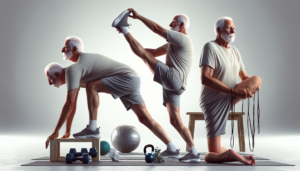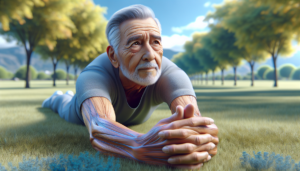Benefits of Yoga for Older Athletes
Yoga offers a plethora of advantages for older athletes, encompassing both their mental and physical well-being. The practice of yoga has gained significant momentum, with participation increasing by over 50% in the U.S. over the last four years, indicating a growing interest among individuals, including athletes.
Mental and Physical Health Benefits
Engaging in yoga can significantly benefit the mental and physical health of older athletes. Yoga helps in improving flexibility, balance, strength, and endurance, which are vital components of overall fitness. Additionally, it aids in reducing stress, promoting relaxation, and enhancing focus and mindfulness. According to MM Learn yoga can ease the aging process by offering various advantages, making it essential for older athletes looking to maintain their fitness levels.
Growth in Yoga Participation
The increasing participation in yoga highlights its universal appeal and benefits for individuals of all ages. This rise in engagement is a testament to the positive impact yoga has on overall health and well-being. Older athletes are increasingly turning to yoga to complement their fitness routines and enhance their athletic performance. Joining senior male yoga classes or attending senior men’s yoga workshops can provide a supportive environment for older men looking to explore the benefits of yoga in a safe and welcoming space.
As athletes age, maintaining a balance between physical activity and mental well-being becomes crucial. Yoga offers a holistic approach to fitness that not only enhances physical abilities but also fosters mental clarity and emotional balance. Embracing the practice of yoga can lead to a more fulfilling and sustainable fitness journey for older athletes seeking to rejuvenate their health and well-being.
Yoga Practices for Aging Athletes
In the realm of fitness and yoga, older athletes are increasingly recognizing the profound benefits that yoga can offer in nurturing both the body and mind. Exploring the intersection of yoga and athletic pursuits can unveil valuable insights into enhancing overall well-being. Let’s delve into how professional athletes embrace yoga, the significance of body awareness in sports, and the impact of yoga on athletic endeavors.
Professional Athletes Embracing Yoga
A growing number of professional athletes, such as Michelle Wie West, Cristiano Ronaldo, Blake Griffin, and Tom Brady, have integrated yoga into their training routines to elevate their physical and mental capacities, ultimately enhancing their performance levels and honing their body awareness (Flow Yoga Center). By incorporating yoga, these athletes have found that the practice not only complements their existing regimens but also fosters a deeper sense of connection between their mind and body.
Importance of Body Awareness in Sports
Former U.S. Olympic and Women’s Grand Tour cycling champion Mara Abbott emphasizes the vital role of establishing a profound relationship with one’s body to unlock peak potential in sports. This highlights the criticality of body awareness, an aspect that yoga proficiently facilitates (Flow Yoga Center). The practice of yoga can help athletes tune in to their bodies, enhancing proprioception, balance, and overall awareness, thereby reducing the risk of injuries and optimizing performance.
Impact of Yoga on Athletic Endeavors
While physical exercise remains essential for aging athletes to build resilience and vitality, yoga emerges as a pivotal component in augmenting their athletic pursuits. Tantric yoga, which emphasizes success (artha), pleasure (kama), path (dharma), and liberation (moksha), presents a holistic approach to enriching the physical, mental, and spiritual dimensions of an individual, especially as they age (Yoga Chicago). By engaging in yoga practices tailored to their needs, aging athletes can cultivate a harmonious balance between body and mind, promoting longevity and excellence in their athletic endeavors.
As aging athletes explore the profound benefits of yoga, they embark on a transformative journey towards holistic well-being, empowerment, and resilience. By embracing yoga alongside their athletic pursuits, older athletes can not only enhance their physical capabilities but also foster mental fortitude and body awareness, leading to a more fulfilling and enriched athletic experience.
Yoga Philosophy for Aging Gracefully
As individuals age, embracing practices that promote both physical and mental well-being becomes increasingly important. In the realm of yoga for older athletes, there is a profound connection between the philosophy of yoga and the art of aging gracefully. Let’s delve into the elements of success in aging athletes and the significance of contentment in the aging process.
Elements of Success in Aging Athletes
Jim Shaw, an advocate for aging athletes, emphasizes the importance of finding contentment in maximizing one’s capabilities, joy, success, and liberation. This echoes the essence of santosha, an observance in Patanjali’s eight limbs of yoga, which underlines the significance of contentment in leading a fulfilling life. By incorporating this principle into their outlook, aging athletes can cultivate a sense of gratitude for their bodies and achievements, fostering a positive mindset and resilience in the face of challenges that come with age.
Importance of Contentment in Aging
Santosha, or contentment, is considered a vital trait among individuals who age gracefully. Embracing life’s uncertainties with contentment enables older athletes to harness their full potential without succumbing to the limitations often associated with aging. By practicing contentment, older athletes can focus on the present moment, appreciate their accomplishments, and accept themselves for who they are, fostering self-compassion and inner peace.
Aging athletes can also benefit from incorporating gentle yoga practices into their routine to enhance overall well-being and promote mindfulness. The art of contentment extends beyond physical capabilities to encompass mental clarity, emotional balance, and a deeper connection with oneself. By integrating the principles of santosha into their yoga practice, older athletes can navigate the aging process with grace, acceptance, and a renewed sense of purpose.
In essence, the philosophy of yoga offers aging athletes a holistic approach to wellness that goes beyond physical strength and flexibility. By embracing contentment as a guiding principle and integrating it into their daily lives, older athletes can cultivate resilience, gratitude, and a profound sense of fulfillment as they navigate the journey of aging with grace and wisdom.
Yoga for Older Adults
As individuals age, maintaining mobility levels and vitality becomes increasingly important. Yoga is a holistic practice that offers numerous benefits for older adults. The National Institute on Aging emphasizes that yoga comprises four main types of exercise – endurance, strength, balance, and flexibility – all of which play a crucial role in positively impacting health as people age.
National Institute on Aging Recommendations
The National Institute on Aging recommends yoga as a beneficial form of physical activity for older adults. By engaging in yoga, older individuals can work on improving their endurance, strength, balance, and flexibility, which are essential components for healthy aging. These elements of exercise not only help in maintaining physical fitness but also contribute to overall well-being and quality of life in the aging process.
Yoga Poses for Enhancing Health
A 2013 study published in BMC Complementary and Alternative Medicine examined the effects of specific, minimally modified yoga poses on older adults. The study focused on assessing the physical demands on anatomical areas such as the ankle, knee, and hip when practicing yoga. By developing strength in these areas through dedicated yoga practice, older adults can enhance their balance, reduce the risk of falls, and improve overall stability as they navigate daily activities (Forbes).
It’s crucial for older adults to approach yoga with caution, especially when starting a new exercise routine. Considerations must be made for physical limitations and preexisting conditions like osteoporosis, arthritis, balance issues, and uncontrolled high blood pressure. Paying attention to these factors is essential to ensure a safe and effective yoga practice tailored to individual needs and capabilities.
To minimize risks and maximize the benefits of yoga for older adults, modifications and adaptations to poses are often necessary. Most yoga postures can be altered to accommodate specific needs and physical limitations, ensuring a safe and comfortable practice. The use of props like blankets or bolsters, along with tailored adjustments, can significantly reduce the risk of injury and discomfort during yoga sessions (Forbes).
Given the prevalence of frailty among older adults, which affects approximately 7 to 12 percent of individuals over 65 years old in the United States, incorporating yoga into daily routines can provide immense benefits. By focusing on gentle movements, strength-building poses, and mindful practices, older adults can enhance their overall well-being and combat the effects of frailty (Washington Post).
Precautions and Modifications
It’s essential for older adults to approach yoga for seniors with caution, particularly when incorporating a new form of exercise into their routine. Older men should be mindful of their physical limitations and any preexisting conditions they may have, such as osteoporosis, arthritis, balance issues, or uncontrolled high blood pressure, when engaging in yoga practice. Adhering to safety tips and making necessary modifications are crucial to ensure a safe and beneficial yoga experience for older athletes.
Safety Tips for Older Adults Practicing Yoga
When embarking on a yoga journey, older men should prioritize safety to prevent any potential injuries or discomfort. Here are some safety tips for older adults practicing yoga:
- Always consult with a healthcare provider before starting a new exercise regimen, including yoga, especially if there are existing health concerns.
- Listen to your body and practice self-awareness during yoga sessions. Discontinue any pose that causes pain, discomfort, dizziness, or shortness of breath.
- Avoid overexertion and gradually progress in your practice to prevent strain or injury.
- Stay hydrated and maintain proper breathing techniques throughout your yoga practice to enhance relaxation and focus.
- Choose a qualified instructor who is experienced in teaching yoga for older men and is aware of modifications for physical limitations.
Modifications for Physical Limitations
Most yoga poses can be adapted to suit individual needs and accommodate the physical limitations that older adults may face. It’s crucial to modify or avoid poses that could exacerbate existing conditions or cause discomfort. Here are some common modifications for physical limitations in older athletes:
- Use props like blankets, bolsters, straps, or blocks to support your body and enhance stability during poses.
- Maintain proper alignment and adjust the intensity of poses based on your comfort level.
- Engage in chair yoga or gentle yoga for older men to reduce strain on the joints and enhance accessibility for those with limited mobility.
- Avoid poses that involve deep backbends, forward bends, or intense twists, especially for individuals with osteoporosis, as recommended by the National Osteoporosis Foundation.
- Consider practicing under the guidance of a qualified instructor or participating in senior men’s yoga workshops to ensure proper alignment and minimize the risk of injuries.
By incorporating these safety tips and modifications, older athletes can enjoy the physical and mental benefits of yoga while minimizing the risk of discomfort or injury. Remember that practicing yoga should be a pleasant and enriching experience, promoting overall well-being and longevity in your fitness journey.
Specific Yoga Flow for Older Athletes
For older athletes looking to incorporate yoga into their fitness routine, a tailored yoga flow can offer a range of benefits in just a few minutes. Let’s explore the advantages of a 7-minute yoga routine and the pose sequence designed to enhance overall well-being.
Benefits of a 7-Minute Yoga Routine
A quick 7-minute yoga routine, as recommended by Terecita “Ti” Blair, the 2017 SilverSneakers Instructor of the Year, can be a game-changer for older athletes. This condensed routine focuses on standing poses that help ease stress, increase flexibility, and build strength, all essential aspects for maintaining fitness and mobility as we age.
By emphasizing the connection between breath, mind-body awareness, and movement, this short yoga flow offers older athletes the opportunity to engage in a comprehensive practice that supports their physical and mental well-being. The sequence is designed to be accessible and can be practiced anywhere, making it an ideal addition to a daily fitness regimen.
Pose Sequence for Enhancing Well-being
The 7-minute yoga flow for older athletes includes a variety of standing poses that target different aspects of physical fitness, such as balance, strength, and flexibility. Some key poses in this sequence may include:
- Mountain Pose: Establishes a strong foundation and improves posture.
- Cactus Chest Expansion: Opens up the chest and shoulders for better breathing.
- Chair Pose: Strengthens the legs and core muscles.
- Wide-Legged Forward Fold: Stretches the hamstrings and increases flexibility in the hips.
- Warrior Two: Builds strength in the legs and helps improve balance.
- Reverse Warrior: Stretches the side body and enhances spinal mobility.
- Triangle Pose: Increases flexibility in the spine and legs while promoting overall stability.
These poses are carefully selected to address common areas of concern for older athletes, promoting physical health and vitality. However, if you have chronic conditions, injuries, or balance issues, it’s essential to consult with your healthcare provider before starting this or any exercise routine to ensure safe and appropriate practice (SilverSneakers).
Remember that modifications may be necessary based on individual needs and abilities. It’s important to listen to your body, practice mindfully, and adjust the poses as needed to suit your level of comfort and safety (SilverSneakers). By integrating this short and effective yoga flow into your daily routine, older athletes can not only enhance their physical health but also experience mental clarity, relaxation, and an overall sense of well-being.



